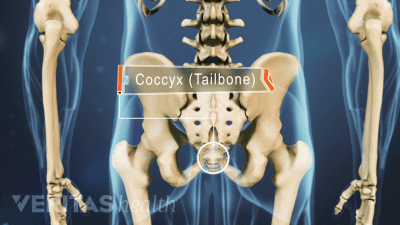Coccydynia, or tailbone pain, is persistent pain at the bottom of the spine due to injury or inflammation in or around the coccyx.
The coccyx consists of three to five small bones that are fused, or nearly fused, with only limited movement between them. The coccyx varies in size from person to person. In men, the hip is aligned more upright, and the sacrum is rotated inward. In women the hip is tilted forward, and the sacrum is rotated outward.
When seated, men will primarily bear the weight on the lower parts of the hip, called the ischial tuberosities. Women are more likely to bear some weight on the coccyx, making them more likely to acquire coccydynia.
Coccydynia typically occurs when the bones in the coccyx move beyond their limited range of motion, which causes the ligaments between the bones of the coccyx to become inflamed. Typical causes include falls, childbirth, or sitting for long periods of time.
The pain from coccydynia is usually much worse while sitting, or when moving from a sitting to a standing position.
While injury to the coccyx area can usually heal on its own, it is still important to seek an accurate diagnosis and care plan to help prevent it from worsening or becoming chronic.
Recommended for You







